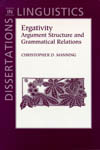

|
|
|
|

ErgativityArgument Structure and Grammatical Relations This volume considers and examines some of the phenomena that have led languages to be considered ‘ergative’. Languages considered 'ergative' have only been sparsely studied, and many fundamental questions in their analysis seem at best incompletely answered. This volume fills that void by focusing on some of the basic issues: when ergativity should be analyzed as syntactic or morphological; whether languages can be divided into two classes of syntactically and morphologically ergative languages, and if so where the division should be drawn; and whether ergative arguments are always core roles or not. Christopher Manning's codification of syntactic approaches to dealing with ergative languages is based on a hypothesis he terms the ‘Inverse Grammatical Relations hypothesis.’ This hypothesis adopts a framework that decouples prominence at the levels of grammatical relations and argument structure. The result is two notions of subject: grammatical subject and argument structure subject and a uniform analysis of syntactically ergative and Philippine languages. These language groups, the syntactically ergative and Philippine languages, allow an inverse mapping in the prominence of the two highest terms between argument structure and grammatical relations. A level of argument structure is shown to be particularly well motivated by the examination of syntactically ergative languages. A study of Inuit, Tagalog, and Dyirbal shows that constraints on imperative addressee and controllee selection, antecedent of anaphors, and the controller of certain adverbial clauses are universally sensitive to argument structure. Thus, these phenomena are always accusative or neutral, explaining why passive agents and causes can generally bind reflexives. However, constraints on relativization, topicalization, focusing or questioning, specificity or wide scope, coreferential omission in coordination, etc. are shown to be universally sensitive to grammatical relations. Examining just these phenomena, which are sensitive to grammatical relations, it becomes evident that many languages are indeed syntactically ergative, and so must be countenanced by linguistic theory. This volume combines good scholarship with innovative ideas into an important work that will appeal to a wide range of linguists and scholars. was a lecturer in the Department of Linguistics at the University of Sydney at the time of this publication. Contents
10/1/96 ISBN (Paperback): 1575860368 (9781575860367)
|
Distributed by the
University of Chicago Press |
|
pubs @ csli.stanford.edu
|
CSLI Publications
Stanford University Cordura Hall 210 Panama Street Stanford, CA 94305-4101 (650) 723-1839 |